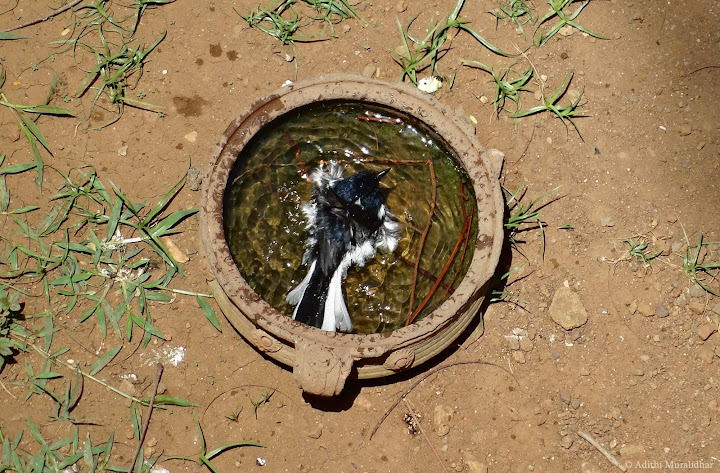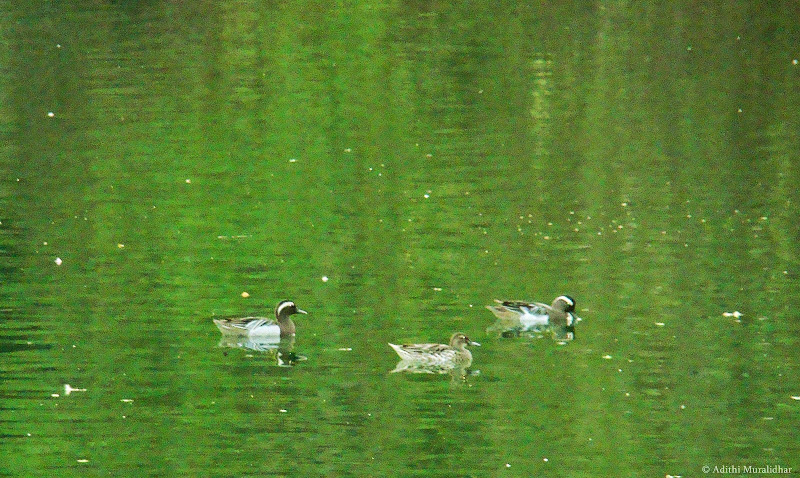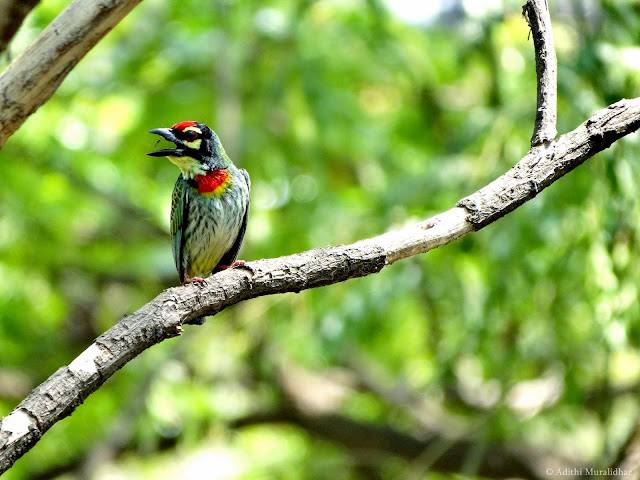Growing Amidst Nature
by Adithi Muralidhar
Mumbai
is a city I look up to when I think of a forest in a city. I fancy its long but
recent natural history, of tigers roaming the islands, sloth bears digging into
termite mounds, and leopards that once lived in harmony with humans. Most, if
not all, is now lost. As I read Dr Salim Ali’s autobiography The Fall of a Sparrow (ch. Special Providence, pp. 4–5), I came to realise that Mumbai did not lose
its charm until recently. What caught my attention was his recount of Chembur,
a part of Mumbai Metropolis, and probably one of the busiest corners of the
city today. In his own words, “[…] Chembur – now a noisy part of the
metropolitan Bombay but in those days a delightfully quiet sylvan haven of
secondary moist-deciduous jungle set among outlying hillocks of the Western
Ghats [...] It was thickly wooded in parts till uniformly denuded
into a veritable Rock of Gibraltar by the relentless fuel-hunters.” My association with Mumbai is mostly intact
because of its green pockets, but how I wish to experience what Dr Ali felt
over hundred years ago: “The spirited song of the Magpie-Robin which
regaled us at daybreak as we lay half awake, reluctant to leave our cosy beds,
is one of the earliest and most cherished of my ornithological memories. They
bring back those matchless, carefree school vacations in Chembur every time I
listen to a Magpie-Robin’s song, no matter where.” Adithi recounts her childhood in the exact location Dr Ali reminisces,
and he would have been pleased to know that the Magpie Robin still sings in
this part of the city, although the hyena is long vanished. In Adithi’s words…
The relationship I share with Nature goes back for as long as I remember. I was born in a small green pocket within Mumbai city and for a long time I thought Mumbai was that green. It was fifteen years later that I realised that the green place I called home was one of a kind, one of the last remaining wild lands in Mumbai where one could live with nature in its true essence.
My childhood days involved countless
occasions of interactions with nature. While walking to school or on the way
back, my mom would point at the different birds that we would see. “That’s a Magpie Robin”, she would tell
me and my friends pointing to the black and white bird that chirped away for
everyone to hear. I would notice the trees and their flowering season, the
birds that we saw only during winters, the occasional snake that would slither
away without anyone noticing. I was so enamoured with the way nature worked,
everything used to amaze me as a kid. It was for this reason I joined a local nature club, an association run by an enthusiastic and nature loving
couple with their daughter. With them, I travelled to nearby forests, mudflats
and villages, and learned about birds and animals and their habitat. We learned
to notice and observe birds more intently. As part of the club, we also planted
two saplings in the garden
complex of my former residence.
 |
| A Magpie Robin bathes in a water pot kept in the backyard |
During my childhood, picnics did not mean
going to amusement parks or theme parks. It meant finding the most shade-giving
tree near to our apartment building and pitching up a small tent-like
structure.
I remember this one time when me and my
friends (we all were 10 or 12 years old) planned a picnic which basically
involved us carrying a couple of bed-sheets and home cooked food to the nearby
housing society about 200 meters away. The adjoining building had a huge
playground. At the fringes of the playground, there were several Plumeria trees. Their short height and
sturdy branches were good enough to carry our weight. We climbed them and tied
our bed-sheets on to two trees which served as our roof”. We placed another set
of bed-sheets on the ground and lo! Our campsite was ready! We spread out our
food…those from south went for puri-bhaji
while those from north lunged for the idli
and dosa! Such simple and joyful
times contributed to our happy childhood. The gentle breeze was enough for the pale
yellow Plumeria flowers to fall from
the branches… I remember lying on the sheets for an afternoon siesta, watching
each flower gliding gently on the tender breeze…
| Childhood picnics to natural spaces often form the basis of inculcating interest in nature amongst children |
We also once had a kitchen garden in our
building. Our mothers guided us and gave us tips on tending the garden. We
planted tomatoes, brinjal and some herbs. We also emptied our kitchen waste as
compost into the garden pit. After school, I would rush down to the garden to
water the plants. And soon enough, the tomato plant bore several fruits. I
remember waiting patiently for a week till the fruit grew bigger and riper for
us to pluck it. A tomato from our very own garden! The wait, which seemed like
forever, finally came to an end and four tomatoes were distributed amongst the
four of us kids who tended the garden. My sister and I joyfully brought home
the one tomato to show off to our parents the fruit of our hard labour. My
mother of course beamed with pride seeing her two kids taking keen interest in
such an activity. The plan was to cut the tomato (like a cake-cutting ceremony)
during dinner and relish the tasty fruit with our family. I also remember me
and my sister being extremely upset when that very same day my dad eventually came back from the office and made rassam unknowingly
using our tomato!
I remember the time when I was really upset
about leaving my apartment and shifting to another one just a few hundred feet
away. But one of the things that made me accept the new apartment was the path
that led to it (from my old building) through a forest; barely a hundred meter
winding kuchha path through the
forest. I remember walking with my grandmother through that forest when a snake
crossed our path. I was scared, but my grandmother didn’t lose her calm; she
held on to me and said wait, don’t run,
stay here. Let it pass. And we watched the exceptionally long yellowish
brown snake cross our path for a good 5 seconds! There were many such small
green forest patches in the colony and I occasionally would traverse through
them to reach shops, buildings or school. The “short-cuts” through these
patches soon became my favourite pass-time.
My school was located in a fairly open
space, but the location where I completed by grade 11 and 12, was nothing short of a picturesque painting. Just behind the
college was a lake with green waters. There was a small rock island in the lake
where many birds would come and rest, particularly during winters. I remember
having spotted a couple of Garganey
(Anas querquedula) there once!
 |
| Garganey, a winter visitor to the Indian subcontinent. |
During monsoons, this place would turn
greener with kingfishers zooming past and catching fish. Freshwater Turtles (or
terrapins) could be seen swimming just under the surface of the water as they came
up for an occasional breather. Unfortunately the lake was fenced on all sides
and we could never venture too close to it. Thanks to some meddling residents
who did manage to break the fence, the lake ended up being a “visarjan point” during Ganesh Festival.
Since then, the broken fence area which is also the only access to the lake is
trashed with plastic, boxes, and flowers. It has also become a breeding ground
for mosquitoes. Never the less, it is still up to this day one of my most
favourite places.
Monsoons meant it was time for some small hikes in the vicinity. I had a great time sighting fresh water mollusks, scintillating insects, bird songs, and other forms of
nature that gave me company during these hikes.
I no longer stay in such a green pocket (and
much to my sadness, the greenery I speak of does not exist the way as it used
to now). But the good thing is that thanks to this connection, I have now
learnt to pay attention to the minutest of details when it comes to nature, on how
to appreciate nature even when I am sitting duck in the middle of peak hour
traffic in Andheri.
| A froglet of the Burrowing Frog in the green pocket of Mumbai |
Today I find pleasure even when I travel
through Mumbai local trains and I see open drains and sewers enroute; for I am
able to observe and appreciate the opportunistic Cattle Egret (Bubulcus ibis) who has found a way to
live in such environments. When I pass Kurla station, I peek into the gutters
that are found between two tracks and observe frogs that are able to live in
that polluted water! Nature has only continued to amaze me day
after day and I am thankful to my childhood experiences because I have learnt
how to truly value all the facets of nature and be grateful to her.
 |
| A Brahminy Kite flies over Vajara Falls in Karnataka |
Since I love rambling about nature to
anyone who is willing to listen, I used to not miss opportunities where I could
interact with youngsters particularly school students and college-goers. I tell
them about my experiences in nature. Their ideas and comments used to help me
understand what kind of views they have about the world around them, what
animals in particular catch their attention, which issues do they consider to
be as "environmental problems". When asked which is their most
favourite, or rather most memorable experience in nature, they would all talk
about a famous tourist stop or a hill station.
I have noticed that all they need sometimes
is a little nudge to get their minds thinking and imagining. Show them a
picture of Coppersmith Barbet. They are mesmerized by her colours. Then ask
them if they can hear that repetitious kuk-kuk-kuk
sound. They appear much surprised when you inform them that the source of that
‘call’ is the Coppersmith Barbet! Rest assured you will have them looking for
the source of sounds in nature the next time they hear this much commonly heard
bird in the city.
 |
| A Coppersmith Barbet - one of the common resident birds of Mumbai's green pockets |
Unfortunately, our green pockets are
shrinking. Not all of us may have the privilege of growing in some green pocket
within a city anymore, but the greenery isn’t ever too far.
There is more than one reason to be in the
midst of nature, and there is a growing body of science that indicates that
exposure to nature at a young age leads to positive environmental ethics (for
more, see this).
Given that we are living in a world where environment takes a back seat, there
is a need for the younger generation to be more environmentally conscious and
sensitive. And all you need to do is be in nature with all your senses open,
and reach out to the plants and animals with an open heart and mind.
--
About the Author: Adithi Muralidhar
Adithi is an ardent nature enthusiast based
in Mumbai and has a keen interest in science and environment education,
sustainability and socio-cultural issues.
She "occasionally" tweets at @Adithi_M
You can contact her here.
--
This work is © Adithi Muralidhar and
has been published with her permission. All the views expressed in this article
are that of the author. Feel free to use the content and photographs of this
article for non-commercial work with an attribute to the author/photographer along with a link back to this page, and would appreciate if you can drop an email to Adithi to let her know that you have used her work.
I am not from Mumbai. I only spent 10 years there and I was fortunate that i stayed in the place that I did - Godrej Hillside Colony. A lot of what Adithi describes, I have seen and experienced. The 7 foot snake that looked warily at me as I trudged across an open glade, the trio of spotted owlets that would keep one eye open to check on me as I crept to photograph them, the small body of water that used for form behind the boundary wall ... these are memories that stay. Unlike Adithi however, I am do not look for life in the gutters or sewage that is Mumbai today. An overwhelming sadness overcomes me as I see the last vestiges of green being destroyed and I feel miserable when I see that cement mixer truck going to another site where the land is dug up for buildings rather than trees to come up.
ReplyDeleteHi Bernard, you've lived in one of the best, and the last, protected sites in Mumbai! I look at frogs in gutters with pessimism as well, but just to see their resiliency, their will to come back and fight back, gives me a hope that when the civilization falls, they will reign supreme again. But I hope it doesn't come to that, instead we must live together in harmony. Unfortunately the managers of Mumbai still fail to see it, what with Sewri and Aarey.
DeleteDear Bernard, when I say -"Today I find pleasure even when I travel through Mumbai local trains and I see open drains and sewers enroute; for I am able to observe and appreciate the opportunistic Cattle Egret (Bubulcus ibis) who has found a way to live in such environments."...... I do not mean to say that I enjoy them and endorse such environments for wildlife. It deeply saddens me each type I see so much filth in the environment..but to see nature thrive in that reminds me how she finds a will to survive..it makes me appreciate nature even more...
Delete